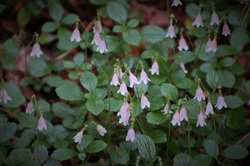 Twinflower is a creeping groundcover most often found in shade. Technically a shrub, Twinflower is in the honeysuckle family. The pale pink flowers are found in pairs and look like tiny lampshades growing on the forest floor. An evening walk in the woods where Linnea borealis grows is a treat, since thats when the plant produces its perfume most strongly. The mat of shiny evergreen foliage is a great foil to the pale pink flowers. It is difficult to tell where the plant stops and starts on the mossy forest floor, there are records of stems growing for more than 10 meters! Twinflower cuttings root easily, and this is a great groundcover for the garden in moist shade.
0 Comments
Nipplewort (Lapsana communis) is another alien species well established at Leaning Oaks. A common weed in the garden and along path edges it thrives in the light shade under our Garry Oaks. The plant starts it's growth as a basal rosette, but shoots up quickly in June and July produces yellow daisies on branches inflorescences. Several websites say the plants common name is from the similarity of the buds to human nipples. This, I think, is the result of botanists spending unhealthy amounts of time isolated from human companionship in remote locations.
An alternate explanation is that the plant was used to treat ulcers on nipples. This species is also used as a spring vegetable, although I have never tried it so I can't vouch for its palatability.  Leaving the lights on at night means that there will be more species found than we will ever get to identify and post! This fuzzy, teddy bear like moth was just one of many that arrived a few nights ago. Lophocampa maculata is a common forest moth, the larvae feeding on a wide variety of hardwoods. The larvae are beautifully coloured with black on either end and orangy in the middle. The "tussock" part of the name is in reference to the hair tufts that the larvae sport. 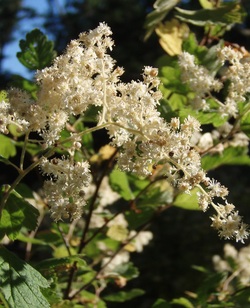 The billowy clouds of cream coloured oceanspray or Holodiscus discolor fill the air with a faint honey perfume and provide multitudes of bees and other insects food and nectar. The blooms that evoke the descriptor of oceanspray start about mid-June until the first week in July. The shrubs grow well...almost too well in open places, particularly with a bit of moisture. This shrub is also known as ironwood -the older wood is truly hard as nails and was used as such. Heating it over a fire made it even tougher. Local aboriginal groups including the Saanich and Cowichan used the wood for spears, building material, halibut hooks and knitting needles. The large Western Tiger Swallowtail is fairly common through western North America in meadows, gardens, woodlands or roadsides often seen "puddling" in wet spots. They seem to nectar on a wide variety of flowers; the horticultural alliums being a favorite. The larvae of this species has funky, colourful eyespots - I will try and find one and post a photograph; but until then, here are some by Jeremy Tatum http://facweb.furman.edu/~snyderjohn/tatum/056-059.htm in the Butterflies & Moths of Vancouver Island. The caterpillars of Papilio rutulus feed on deciduous trees and shrubs, including willows and ocean spray.
 Musk-Flower's (Mimulus moschatus) common name is a reminder of a botanical mystery. Called Musk-flower, or sometimes simply Musk, it was imported to Europe from Western North America as an ornamental plant and grown for its perfumed flowers and foliage. So common was its cultivation in Victorian England that the scent of Musk-flower pervaded towns in the evening. Then in the early 1900's the species suddenly became scentless- both in Europe and in North America. Searching for scented forms has failed to find one. The cause of this peculiar phenomenon has never been explained. Our Musk(less)-flower is dervied from a cutting I took from a plant growing in a ditch along the Galloping Goose Trail. We planted it in the gravel beds alongside the stream we built in the garden. This clearly is a spot to its liking since it has spread aggresively by long underground runners and would take over the entire stream if it wasn't for the several wheelbarrow loads we take to the compost heap each summer. Seedlings pop up around the edge of the pond often, and usually I weed them out - but not before I sniff to see if one of them has re-found the ability to produce the famous musk scent. Oxeye Daisy is a widespread, common introduced plant,found in meadows, fields, and disturbed areas. Formerly this was considered to be a species of Chrysanthemum. That genus has been split into several genera and this is now called Leucanthemum vulgare, which is greek for "white flower". It is a short-lived perennial with very long lasting flowers. Because the species is so widespread it has a multitude of common names besides the one we are using here, includingMoon-Daisy, Moon Daisy, Marguerite, Oxeye Daisy, Dog-daisy, and Dog Daisy. It is seldom eaten by cows and since it can become quite common in hay fields and pastures it is regarded as an important agricultural weed.
Now I've never tried these, but I'm curious, I see that the buds are being picked and pickled and sold as Ox-eye Daisy Capers http://www.wildfoods.ca/products-vegetables-ox-eyedaisycapers.html). 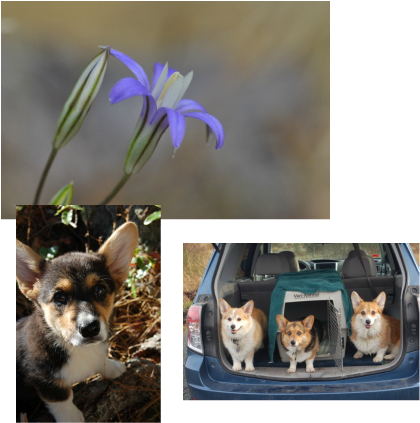 These aren't Brodiaea, but fine examples of short legs. These aren't Brodiaea, but fine examples of short legs. This is another of the perennial herbs that arise from a bulb like corm and are found in the driest of spots in western North America. The purple-blue flowers of Brodiaea coronaria are atop a smooth stalk about 10-30cm tall. There are much shorter species of Brodiaea and those are what we named our first corgi after for their short and stocky "legs". The fact sheet from the Garry Oak ecosystems restoration team: http://www.goert.ca/propagation_guidelines/forbs/brodiaea_coronaria June 9-15 was BC Invasive Species Week, so we decided to highlight a few more of the non-native invasive species found here at Leaning Oaks. Hairy Cat's-ear ( Hypochaeris radicata ) is a yellow flowered perennial with a more or less flat basal rosette with a leafless, branched flowering stem. Flowers are superficially Dandelion-like (see 91), hence another common name of False Dandelion. Unlike Dandelion, the stems are solid and not hollow. It is a common weed of lawns, cracks in pavement and disturbed areas. Like dandelions the seeds are spread by the wind. The leaves are supposed to be hairy like the hair on a cat's ear. I clearly have not looked at enough cat's ears to see the resemblance.
And, just in; "the flowers of this weed are an important spring food for black bears on Vancouver Island". Thanks Helen! Maybe we'll get bears.... Yarrow is very complex taxonomically, but seems to be generally recognized as a single highly variable species. It is widespread through the Northern Hemisphere and found in dry locations from sea level to mountains. Achillea millefolium is used in plantings where a drought tolerant plant with a long bloom season is desired. Butterflies love it!
The genus name, Achillea is derived from Achilles, the hero of Homer's Illiad in Greek mythology. He had been a student of Chiron, a centaur that was apparently renowned for his knowledge of medicinal herbs. Or it may have been that Achilles needed to use yarrow often on his wounded soldiers as they fought thier bloody battles. The list of medicinal uses for this plant is very long just locally; from the Ditidaht and Makah using it as childbirth medication, the Saanich using it in a poultice, the Nuu-chah-nulth for colds and coughs and the Cowichan as a blood-purifier, just to name a few. The species portion of the name, millefolium, means "thousand leaves" , referring to the finally segmented fern like leaves. You count and see if there are a thousand and let us know. Addendum: I thought I was done, but just found this lovely gem from http://www.arkive.org/yarrow/achillea-millefolium/.
 Here at Leaning Oaks, this is the earliest of the Swallowtails to make an appearance. Starting in May, males can be seen patrolling the forest edge and garden areas, often sparring with other males. As the name suggests it is the palest of the 3 Swallowtails that we have here. Males are nearly white, females are very pale yellow. The commonest food plant for the caterpillars of Pale Swallowtail (Papilio eurymedon) on the coast is Red Alder (Alnus rubra), however, it is likely that the Pale Swallowtail here is using Ocean Spray (Holodiscus discolor) as is larval food plant.  Chipping Sparrows (Spizella passerina) are intermittant late spring and summer residents for us here at Leaning Oaks. They arrive in the second week of May usually and are gone by the 3rd week of July. We don't have records for every year either, although there is usually a pair in the neighbourhood. I suspect they are commoner than our records would indicate. One difficulty is that their song sounds a lot like the song of a Dark-eyed Junco (our most abundant songbird). This spring I did a call playback experiment and found the Juncos reacting to the Chipping Sparrow's song quite often - which made me feel a bit better since they couldn't tell the song apart either. 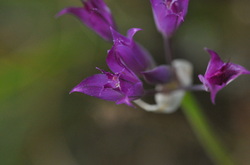 This time it really is an onion (as opposed to the Fool's Onion #121). If you step on or crush Allium acuminatum the pungent smell will leave you no doubt. The very small bulbs are occasionally eaten, but due to the restricted range it is better to stick to those locally grown Saanich Peninsula onions! There can be up to 25 flowers on a stalk, each with the tepals that turn at the tips (a distinguishing feature of A. acuminatum). Another English name I saw was "Taper-tip Onion" ; aptly descriptive. However Hooker has the honours here. Joseph Dalton Hooker was an incredibly active botanist in the 19th century, was a close friend of Darwin's, was the director of the Kew Gardens and had the best eyebrows ever. http://www.jdhooker.org.uk/ Brown-headed Cowbirds (Molothrus ater)are our only regularly occurring Icterid (new world Blackbirds) here at Leaning Oaks. We sometimes have fly-over Red-winged or Brewer's Blackbird, but we have yet to see either of those species land on the property. Despite the fact that this species is a relatively recent arrival to the west coast, its hard to imagine a spring without this species, their liquid call notes and constant head raising displays are a common sound and sight here in May, June and July. We have a few records as early as the first week of March through to the end of August. We have been photographing the birds that come to the gravel stream the past month, and we've noticed that the female cowbirds come to bathe often - but we have yet to see a male bathe. Rcently we have noticed that at twilight small flocks of Brown-headed Cowbirds can be seen flying northward, presumably off to roost in a suitable spot.
I learned a valuable lesson this weekend--never clean your windows. I inadvertently killed this beautiful Potter Wasp, Eumenes crucifera by spraying vinegar where it was hiding in a gutter. As it crawled slowly out, sputtering and shaking, I realized I had never seen this species before. Drying it off and mouth to mouth did not work.
Potter Wasps are solitary and make small amphora type pots out of mud for nests. Some species of the potter wasps will paralyze a caterpillar (or several smaller ones), stuff them in the nest where they will lay an egg and then seal the egg in the pot with this ready food source for when the larva emerges. I have now been peering intently at all the twigs in shady areas to see if I can find one of these exquisite wee nests. There are a lot of surfaces on Leaning Oaks in the shade. I kept calling this an onion, and then felt somewhat vindicated when I saw that one of the English names was "False Onion". It is presently Triteleia hyacinthina but is has been in the Brodiaea genus. It has no onion scent or flavour, but does grow from a bulb-like corm. It is yet another of the plants that grow in the meadow or forest edge that are adapted to the dry summers and moist winters.
 Vanilla Leaf (Achlys triphylla) is a member of the Berberadaceae, a family of plants that are quite useful here at Leaning Oaks, since many members of this family are not eaten by deer . Our unfenced ornamental garden has a disproportionately large number of Beberadaceans. This stand of Vanilla Leaf is from the garden , a small portion of rhizome was transplanted from the woods below the house into the flower garden 5 years ago. Like many members of this family, they produce almost all their leaves in one burst annually, so the initial transplant looked a little woebegon for the first year. Each year however, the area covered by these attractive leaves has steadily increased - and now it covers a sizeable patch in the garden. Vanilla leaf is a very good plant for one of the most difficult areas to garden in - dry shade. Vanilla Leaf is named after the smell of the drying leaves, formerly used as a a room deodorizer and an insect repellent. Since the fresh leaves have no discernable scent, one of the other common names is Sweet-After-Death. The active ingredient in terms of both the perfume, and it's insecticidal properties is a chemical called coumarin. 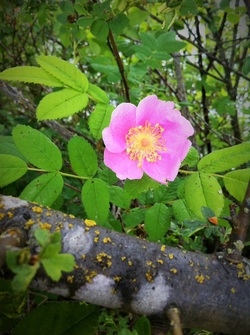 Nootka Rose (Rosa nutkana var. nutkana ) is in full bloom right now and the smell of the flowers is easily detectable when passing a shrub, especially in the evening. Unlike most other roses, Nootka Rose is detectable by one's nose even when its not in bloom, since the foliage has a spicy metallic smell. The smell always reminds me of childhood bike rides, often at the very end of the day - pushing way past the "be home before dark" curfew. The swampy section of Arbutus Road on the north end of Salt Spring Island was detectable by the aromatic foliage of the Nootka Rose -and it signified that the next driveway to the right was home. The flowers of this rose are significantly larger than the flowers of 111. Baldhip Rose, and it grows in much damper locations. Here at Leaning Oaks it is restricted to the very lowest point on the property. In winter, especially in full sun locations, the fruiting bodies or hips are very showy. Rose hip pie is a delicious, but the need to make sure the outer hip is used but all of the irritating hairy seeds are avoided make it a somewhat labour intensive dessert. Western Tanagers (Piranga ludoviciana) are a summer bird for us. They arrive the last week of April and stay until the first week of September. Our best looks almost always are when then come to the pond to bath and drink. To be more accurate, they are particularly attracted to the gravel beds that we built to filter the pond water. The shallow water flowing over the rocks and gravel are the favourite bathing area for many species, including these tanagers, Purple Finches, Spotted Towhees, Dark-eyed Juncos, Warblers and others. This summer we intend to spend part of a day in a blind photographing the bathers, until then, these photos were "shot from the hip" during happy hour last Sunday on the deck beside the water features.
The Bubble Story
Once a newly hatched spittlebug is hatched it will wander until it finds a suitable host plant with a succulent supply of sap. The beak is inserted down to the xylem and they begin to suck considerable quantities of sap. The excess water and sugar is forced through the gut and out the anus where it adheres to the plant and nymph which moves the liquid over its body using the back legs. The nymph breathes through spiracles on the outside of the abdomen. Bubble making happens by vigorous movements of the abdomen as the nymph sucks air into its abdominal breathing tube and forcing it out, while pumping its abdomen and moving it every which way. There is a mucilaginous substance that is exuded from glands on the abdomen that keeps the bubbles from collapsing…and why the goober balls feel so slimy when you get them on your legs as you are walking. This foam keeps away predators, keeps the wee nymph moist and insulated. http://www.sciencedirect.com/science/article/pii/0020179087900096 (the froth composition...should you care to know) The species that we found (pretty sure....I'd like to find an adult to be 100%) on Leaning Oaks is Philaenus spumarius - and *sigh*, it is a European introduction. There are other possibilities here for other species so we will keep looking. It can be a economic pest on some crops if in high densities or when the froth acts as a vector for fungi. So far our rosemary is doing just fine-- Oh--and if you want to identify your spittlebugs, Agriculture Canada has a book for you! On line courtesy of the Entomological Society of Canada: http://www.esc-sec.ca/aafcmonographs/insects_and_arachnids_part_10.pdf |
AuthorsTwo biologists on a beautiful property armed with cameras, smart phones and a marginal knowledge of websites took up the challenge of documenting one species a day on that property. Join along! Posts and photographs by Leah Ramsay and David Fraser (unless otherwise stated); started January 1, 2014. Categories
All
Archives
May 2025
|
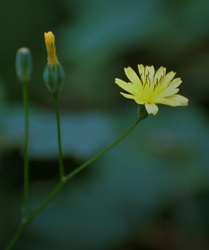
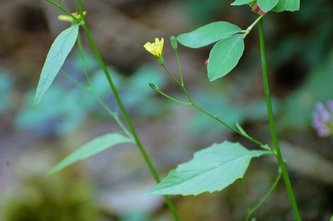
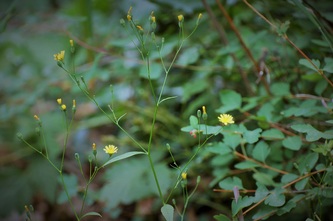
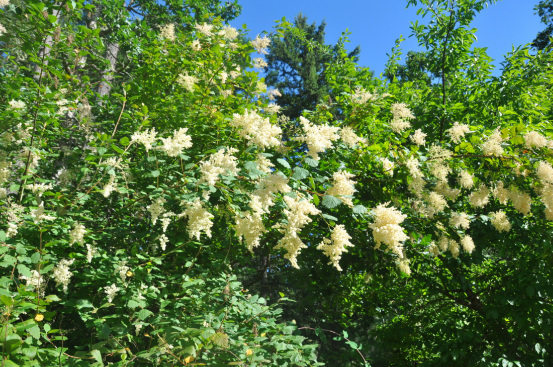
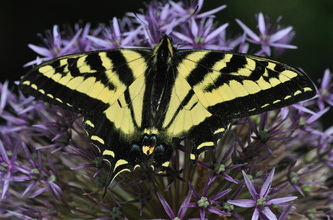

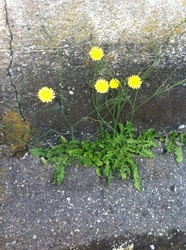
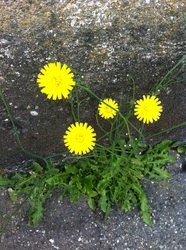
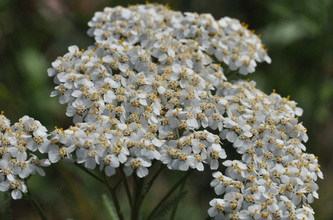
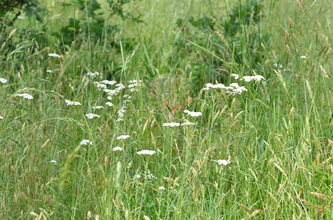
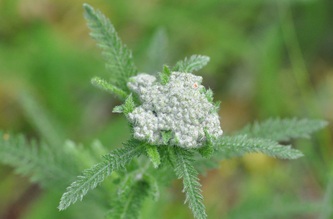
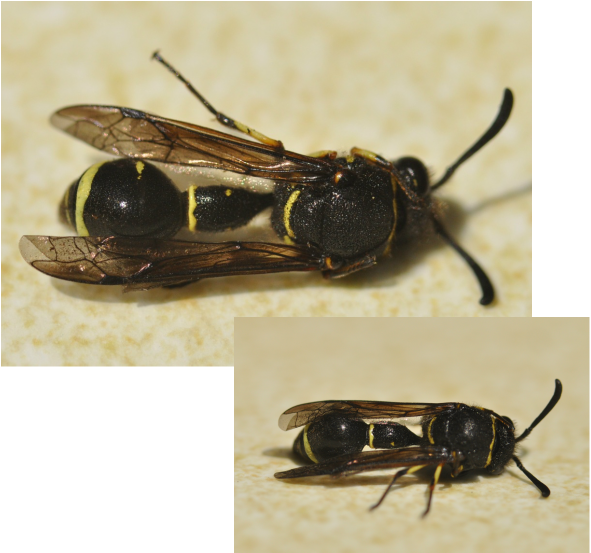
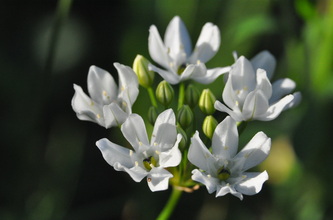
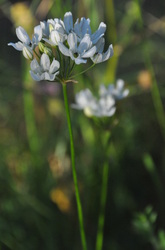
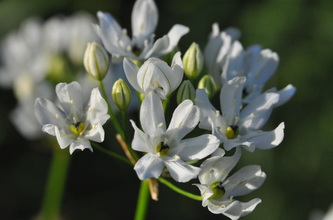
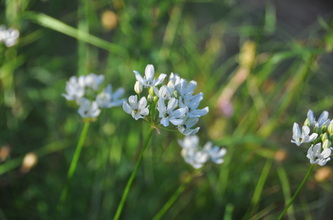
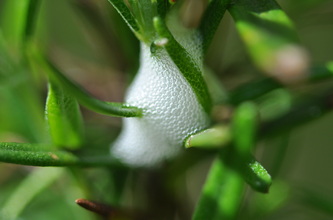
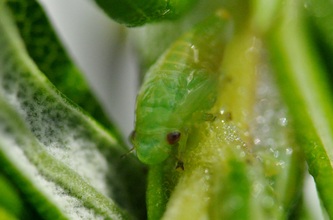
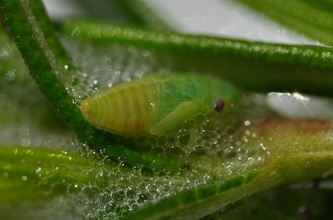
 RSS Feed
RSS Feed